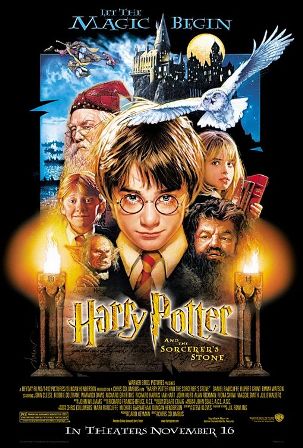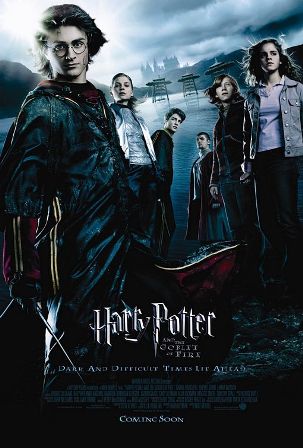CHICAGO – In anticipation of the scariest week of the year, HollywoodChicago.com launches its 2024 Movie Gifts series, which will suggest DVDs and collections for holiday giving.
Film Feature: Harry Potter and the Legacy of a Franchise
CHICAGO – For readers and moviegoers who have come of age with boy wizard Harry Potter, it’s impossible to look back on J.K. Rowling’s immortal series and not be engulfed in a bottomless Pensieve of memories. I wasn’t much of a fantasy buff when I began reading the books. My sister was a fervent fan, and she guaranteed that I would be hooked after the first few chapters.
It ended up only taking a few pages for me to become completely enthralled by Rowling’s fusion of timeless Jungian archetypes, mythological creatures and marvelously inventive wit reminiscent of Roald Dahl.
The bare-bones premise of Rowling’s 1997 debut novel, “Harry Potter and the Philosopher’s Stone,” (changed to “Sorcerer’s Stone” for its 1998 U.S. release) was nearly identical to Dahl’s 1988 classic, “Matilda,” about a lonely child who utilizes her secret magical powers to defy her wicked parents and oafish brother. Like Matilda, Harry finds friendship, foes and ultimately self-actualization at school, though Rowling’s first major twist to the formula was her decision to make the school a magical one. It quickly became a tradition for me to read one “Potter” chapter a night, allowing the endless adventures and mysteries concealed within Hogwarts School of Witchcraft and Wizardry to seep into my subconscious. Since I read each of Rowling’s books only once, watching the subsequent film adaptations has been a glorious journey of rediscovery.
Like most fans, I was weary of any Hollywood studio attempting to cash in on the “Potter” phenomenon, yet Rowling’s close collaboration with the filmmakers was crucial to the success of these cinematic incarnations, which avoid all the pitfalls of soulless franchises. In fact, this may be the greatest film franchise of all time, in part because it functions not as a series of rebooted retreads but as a singular work of cohesive detail and cumulative power. It’s frankly astonishing to behold how the “Potter” pictures have maintained their exquisite quality, impeccable ensembles, narrative momentum and artistic integrity over the last decade. Warner Brothers couldn’t possibly have suspected it was launching a series that would go on to gross over $2 billion. Pint-sized stars Daniel Radcliffe, Rupert Grint and Emma Watson couldn’t have guessed how their identities would become irrevocably attached to their respective roles as Harry, Ron and Hermione. And producer David Heyman couldn’t have predicted that his incomparable cast and crew of veteran British talent would be sustained over eight consecutive pictures.
With the final installment, “Harry Potter and the Deathly Hollows: Part 2,” scheduled to open July 15th, I’ve decided to revisit and rank the previous seven films to illustrate just how much they have evolved and endured over time. Cue the Sorting Hat…
7.) Harry Potter and the Sorcerer’s Stone (2001)

Harry Potter and the Sorcerer’s Stone
Photo credit: Warner Bros.
A good start to a great saga that built the foundation for a lasting franchise. Family-friendly director Chris Columbus (“Mrs. Doubtfire”) was an ideal choice for the early pictures, with his childlike love of slapstick and whimsy.
If the picture is clunky in spots, it’s primarily because the precocious and inexperienced leads are still easing into the cloaks of their heroic trio. Radcliffe is a complete blank slate, sporting the right look but none of the acting chops. Grint is adorably smush-faced and provides many of the best reaction shots, but the effortlessly natural Watson is the only young cast member who truly was a pro right off the bat.
Yet these kids couldn’t have asked for better acting mentors. As malevolent professor Severus Snape, Alan Rickman steals the show with his mesmerizing verbal patterns, while Robbie Coltrane exudes the burly warmth of a rugged teddy bear as gamekeeper Hagrid. He has a knack for absentmindedly dropping clues into casual chit-chat, enabling Harry and his loyal friends to solve the first of many mind-bending puzzles at their mystical boarding school.
The special effects are generally of the cartoonish variety, but Stuart Craig’s production design gives Hogwarts the look and feel of a tangible world as opposed to an expensive set. Along with Craig, screenwriter Steve Kloves (“Wonder Boys”) is surely the most unsung hero of the franchise. Given the unenviable task of condensing Rowling’s sprawling text into a feature-length running time, Kloves has done a spectacular job of pacing the action without settling into the encyclopedic rhythms of a Sparknotes-like synopsis. Of course, what truly makes the material come to life is the unforgettable score by John Williams, which still has the power to produce instant goosebumps.
Pensieve Moment: My sister and I made a habit out of attending every “Potter” film together. After “Sorcerer’s Stone,” we left the theater so energized that we decided to create our own scene-for-scene remake. She handled the camera and I played all the characters. Since neither of us had any editing software, we shot each scene in a linear order, thus requiring me to change costumes after practically every line. Needless to say, we didn’t make it past Platform Nine and Three-Quarters.
6.) Harry Potter and the Goblet of Fire (2005)

Harry Potter and the Goblet of Fire
Photo credit: Warner Bros.
Romantic subplots have always been this series’ weakest element, yet they’ve never been quite as cringe-inducing as they are in this action-packed yet wildly uneven fourth installment. Mike Newell (“Four Weddings and a Funeral”) brought a dryly British sensibility to the characters that continued under the direction of David Yates, but his approach to adolescent soap opera proves to only be sporadically successful.
As Hogwarts competes with two other supernatural schools in the Triwizard Tournament, they enact various traditions, including the Yule Ball, which is sternly defined by Professor McGonagall (played by the ageless Maggie Smith) as an evening of “well-mannered frivolity.” Her dance lesson with Ron is admittedly hilarious, but the subsequent ball is cornball in the extreme. The supposed attraction between bickering pals Ron and Hermione feels entirely forced, evoking memories of Han Solo and Princess Leia in “Return of the Jedi” (at least Harry and Hermione don’t turn out to be siblings).
These awkward growing pains are admittedly typical for any series with the ambition to mature along with its characters. If the introduction of hormones doesn’t quite work here, the emergence of evil does. Brendan Gleeson adds a welcome dash of anarchy to the proceedings as Defense Against the Dark Arts teacher ‘MadEye’ Moody, but it is Harry’s arch-enemy Voldemort (stealthily embodied by a noseless Ralph Fiennes) who produces a serious jolt. The film’s final act is deadly serious, representing the defining turning point of the franchise and superbly setting the tone for everything that followed.
Pensieve Moment: I ran into Harold Ramis at an Evanston screening of “Goblet of Fire,” and got to meet his two sons, both of whom were avid Potter fans. Years later, Ramis told me that he had pursued the film rights before any of the books had been adapted. When the studio offered him to direct book 3 or book 4, he replied, “Well, this franchise isn’t going to last…”


